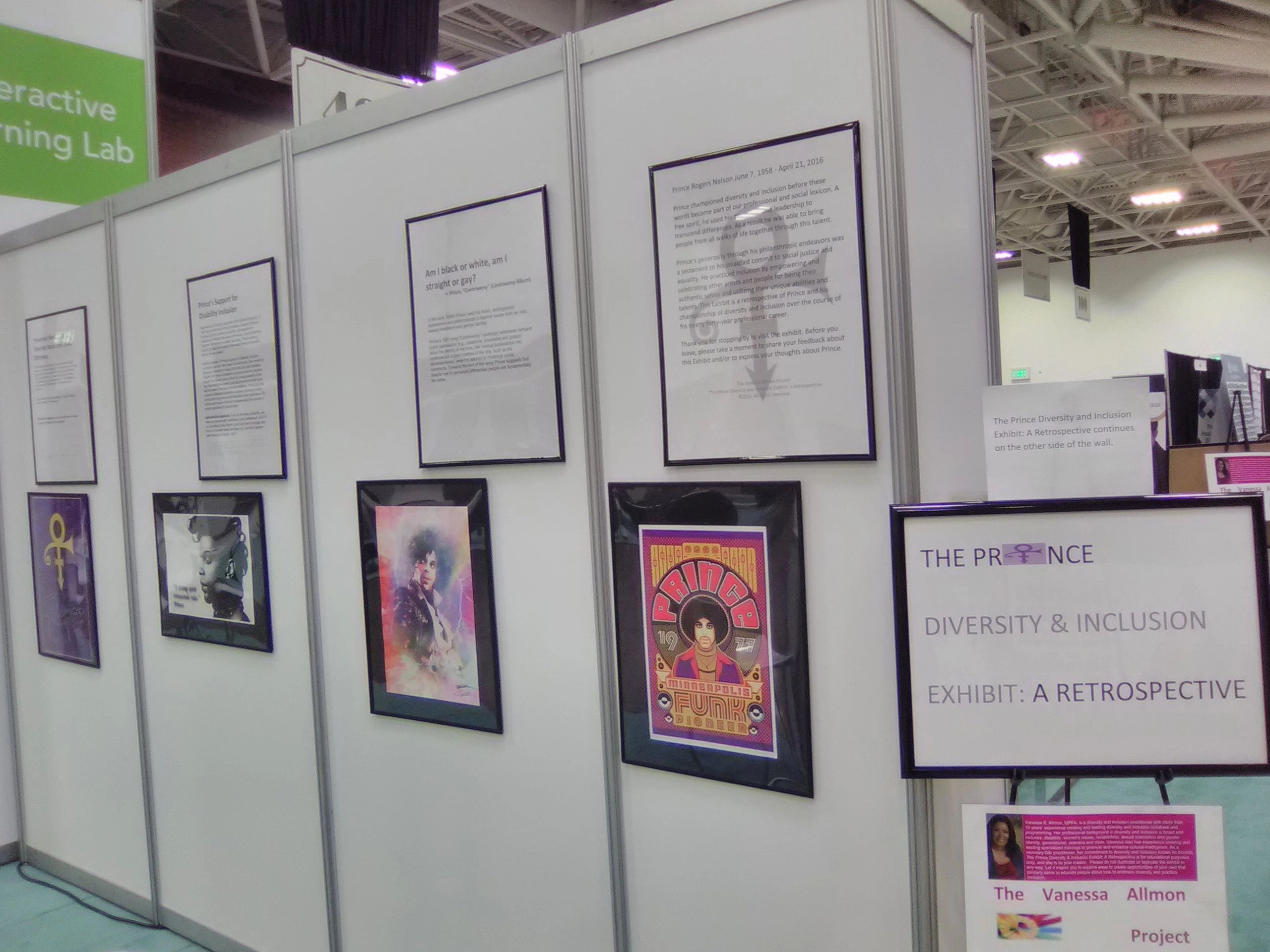 |
| Vanessa K. Allmon, MPPA |
Vanessa conceived of and created “The Prince Diversity and Inclusion Exhibit: A Retrospective.” It is a first-of-its-kind exhibit that serves as a tribute to Prince as a champion of diversity and inclusion throughout his nearly 40-year professional career.
The exhibit is the result of more than 50 hours of extensive research, and consists of a collection of framed large photos and artists renderings of Prince created by number artists. The exhibit allows viewers to explore diversity dimensions that Prince personified and/or embraced through countless collaborations and experiences.
The Prince exhibit has been displayed at Society for Diversity’s Diversity 3.0 conference and at the Forum on Workplace Inclusion in Minneapolis. During Prince’s birthday in June, the exhibit was displayed at the Minnesota State Capitol building.
Vanessa earned a Master's degree in public policy and administration from Northwestern University and received a Certificate in strategic management from The London School of Economics and Political Science. This summer, she began working with a publisher on her first book about self-authenticity in the workplace.
In this Q&A, Vanessa discusses the exhibit and the innovative approach to educating people about diversity and inclusion, while raising their cultural competence.
What inspired you to start the project?
I was inspired by Prince himself. His death had a very profound impact on me: I spent days help crying. At some point, I realized that crying was not going to change the outcome. It was a way to channel my grief and sadness in a positive and constructive way, in a way that would also help others understand Prince’s life.
I was inspired by all the philanthropy that he did throughout his life, anonymously. I also wanted to find something unique about him – something that he wasn’t known for – to share with the world. We all know that he was very talented and good-looking. And on the inside, he was a man of great substance and character. It was a great way to reveal that to the world, and it also happens to fit with what I do professionally.
I’ve been a diversity and inclusion practitioner for almost 11 years. At various organizations, a lot projects thrown my way were related to diversity and inclusion. I started building a portfolio and became known for doing D&I work within organizations where I worked.
Why was this project personally significant for you?
Prince’s death was untimely, and there was so much that he had to give, in terms of sharing his talent with the world. This was a great outlet for me to conduct comprehensive research to find information about his philanthropic work.
In giving to the community, Prince didn’t only focus on race and ethnic issues. He focused on disability, women’s empowerment, among a myriad of other issues. He embraced artists from different generations. He empowered women professionally, who worked for him as engineers, producers and singers. He built a racially and ethnically diverse band. The exhibit also taps a little into LGBTQ issues.
Prince was the kind of person who didn’t seek out attention for his charitable works. The project is intended to be educational and helpful for others to get to know Prince in a different way.
I am working with Hennepin County public libraries, throughout the Twin Cities metropolitan area, to bring the exhibit to various communities. I am also planning to submit the exhibit to an urban walkable public art experience program in Minneapolis early next year. My ultimate goal is to give the exhibit to the Minnesota State Historical Society, and hope that they can house it and keep it on permanent display.
Why is art an effective medium to discussing diversity and inclusion?
Art is a great ice-breaker because it’s a non-threatening way to introduce topics around diversity and inclusion. Art allows for people to self-reflect; they don’t necessarily need to divulge what they’re thinking in a group setting. In the workplace, saying what you truly think could sometimes have negative repercussions. Speaking your mind can sometimes backfire.
I like giving the opportunity for people to think about why they feel a certain way about certain issues. If they’re comfortable enough, I would encourage them to seek out opportunities to address and overcome some of their discomfort with diversity and inclusion.
In the Prince exhibit, I use self-reflection questions, such as “How am I empowering people who are different from myself?” or “Are people with disabilities included in my professional and personal circles?” I hope that the questions help people to formulate a thought pattern that allows them to eventually, walk their talk.
What’s on your wish list?
I’ve had such wonderful feedback: the experience has been humbling and rewarding. Prince is universally well-loved. He transcends race, gender, and other identities. I received feedback that the exhibit has helped others through their grief of his passing.
I want to do more art-related projects, similar to the Prince exhibit. I am hoping that will generate new ways about how we can discuss diversity and inclusion in the workplace that allows people to feel comfortable about D&I concepts.
I am also currently working on a project that involves the discussion on pejoratives in the workplace, specifically, the stereotyping of women of color. I will be doing a talk on the “angry black woman” and how unconscious bias manifests in how people see different people in the workplace, particularly women of color.
In many workplaces, there is the stereotype that women of color are too aggressive, or having abrasive attitudes. I am working on a talk about how we can overcome some of those preconceived and unconscious biases about women of color in the workplace. The goal is to create workplaces that are inclusive and allows space for people to bring their true, authentic self.
Vanessa Allmon on KARE 11 News Minneapolis, Minnesota
Interview by Maileen Hamto

.jpg/:/cr=t:17.38%25,l:0%25,w:100%25,h:65.25%25/rs=w:223,h:223,cg:true)